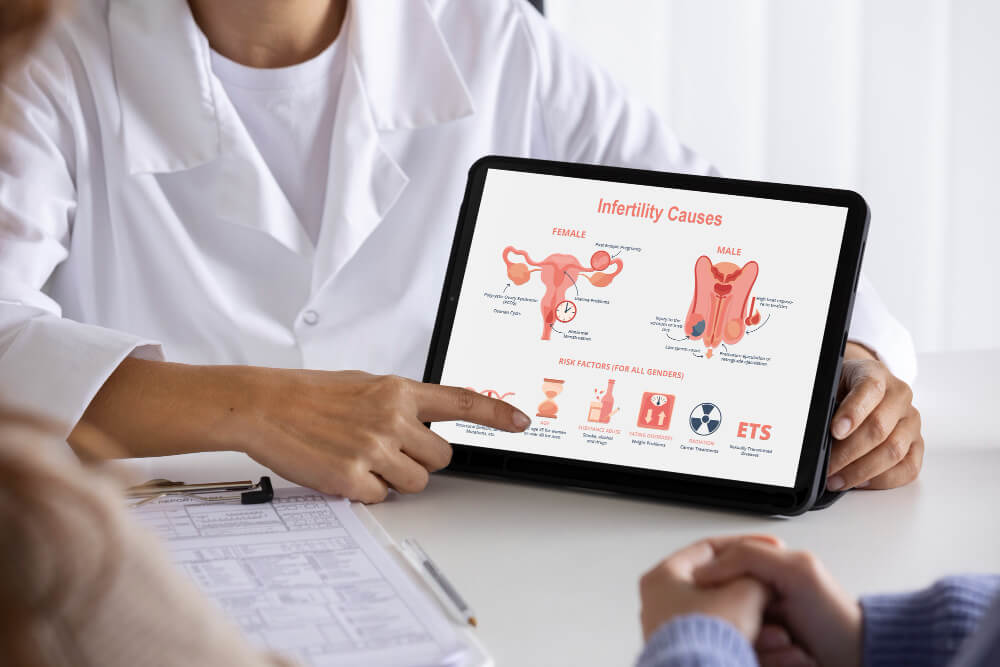
Gynecological health plays a vital role in a woman’s overall well-being. From menstrual issues to reproductive health, being aware of common gynecological conditions is essential for early detection and treatment. While many conditions are treatable, they can impact fertility, quality of life, or even become serious if left unchecked. Here are some common gynecological conditions every woman should be familiar with.
1. Polycystic Ovary Syndrome (PCOS)
What is it?
PCOS is a hormonal disorder that affects women of reproductive age. It is characterized by irregular periods, excess androgen (male hormone) levels, and polycystic ovaries, where the ovaries contain multiple small cysts.
Symptoms:
- Irregular or absent menstrual periods
- Excessive facial or body hair (hirsutism)
- Weight gain or difficulty losing weight
- Acne or oily skin
- Thinning hair or hair loss on the scalp
Why it’s important:
PCOS can lead to complications such as infertility, Type 2 diabetes, and heart disease. Early diagnosis and treatment can help manage the symptoms and reduce risks.
2. Endometriosis
What is it?
Endometriosis occurs when the tissue that normally lines the inside of the uterus (endometrium) grows outside the uterus. This can lead to severe pain, especially during menstruation, and affect fertility.
Symptoms:
- Pelvic pain, particularly during menstrual periods
- Pain during intercourse
- Pain with bowel movements or urination (especially during menstruation)
- Heavy menstrual bleeding or bleeding between periods
- Infertility
Why it’s important:
Endometriosis can severely impact quality of life and is a leading cause of infertility. Early intervention, including medications or surgery, can help manage pain and improve fertility outcomes.
3. Uterine Fibroids
What is it?
Uterine fibroids are non-cancerous growths that develop in or on the uterus. These are common in women of childbearing age and may range in size from tiny seedlings to large masses that can distort the uterus.
Symptoms:
- Heavy or prolonged menstrual bleeding
- Pelvic pain or pressure
- Frequent urination
- Constipation
- Back or leg pain
Why it’s important:
While fibroids are usually benign, they can lead to complications such as anemia due to heavy bleeding, reproductive issues, or even pregnancy complications. Treatment options include medication, surgery, or minimally invasive procedures.
4. Pelvic Inflammatory Disease (PID)
What is it?
PID is an infection of the female reproductive organs, often caused by sexually transmitted infections (STIs), such as chlamydia or gonorrhea. If left untreated, it can cause permanent damage to the reproductive organs.
Symptoms:
- Pain in the lower abdomen or pelvis
- Unusual vaginal discharge with an unpleasant odor
- Painful urination or intercourse
- Irregular menstrual bleeding
- Fever and chills
Why it’s important:
PID can lead to serious complications like chronic pelvic pain, infertility, and ectopic pregnancy (when a fertilized egg implants outside the uterus). Early treatment with antibiotics can prevent long-term damage.
5. Ovarian Cysts
What is it?
Ovarian cysts are fluid-filled sacs that develop on or inside the ovaries. While many cysts are harmless and go away on their own, some can cause pain or complications if they rupture or become too large.
Symptoms:
- Pelvic pain, particularly during menstruation
- Bloating or swelling in the abdomen
- Pain during intercourse
- Nausea or vomiting if the cyst twists or ruptures
Why it’s important:
Most ovarian cysts are benign, but in rare cases, they may be cancerous or cause complications such as ovarian torsion. Regular monitoring and treatment, if needed, can help manage cysts effectively.
6. Cervical Dysplasia
What is it?
Cervical dysplasia refers to abnormal cell changes on the surface of the cervix, which can be detected through a Pap smear. It’s often caused by human papillomavirus (HPV) infection and, if untreated, can lead to cervical cancer.
Symptoms:
Cervical dysplasia typically does not cause symptoms and is usually detected during routine cervical screening.
Why it’s important:
Cervical dysplasia is a precancerous condition, and early detection through regular Pap smears can prevent the development of cervical cancer. Treatment options depend on the severity of the abnormal cells and may include monitoring or removal of the affected tissue.
7. Vaginal Infections (Vaginitis)
What is it?
Vaginitis refers to infections or inflammation of the vagina, which can result from bacterial, yeast, or parasitic infections.
Types of Vaginitis:
- Bacterial Vaginosis: Imbalance of bacteria in the vagina
- Yeast Infections: Overgrowth of Candida fungus
- Trichomoniasis: A sexually transmitted infection caused by a parasite
Symptoms:
- Abnormal vaginal discharge (gray, white, yellow, or green)
- Foul-smelling odor
- Itching or irritation in the vaginal area
- Pain during intercourse or urination
Why it’s important:
Untreated vaginitis can lead to more serious infections or complications, especially if caused by an STI. Proper diagnosis and treatment with antibiotics, antifungals, or other medications can resolve the issue.
8. Menstrual Disorders
What is it?
Menstrual disorders include a wide range of issues related to the menstrual cycle, such as heavy periods (menorrhagia), painful periods (dysmenorrhea), or absent periods (amenorrhea).
Symptoms:
- Extremely heavy or prolonged bleeding
- Severe cramps or pelvic pain
- Skipped or irregular periods
- Spotting between periods
Why it’s important:
Menstrual disorders can affect daily life and signal underlying health issues such as hormonal imbalances, uterine fibroids, or thyroid problems. Depending on the cause, treatment options may include medication, hormonal therapy, or surgery.
Conclusion
Understanding these common gynecological conditions can empower women to take charge of their health. Regular gynecological checkups, including Pap smears and pelvic exams, are essential for early detection and prevention of complications. If you notice any unusual symptoms or have concerns about your reproductive health, don’t hesitate to consult a healthcare professional. Early intervention and treatment can make a world of difference in managing these conditions and maintaining long-term health.


